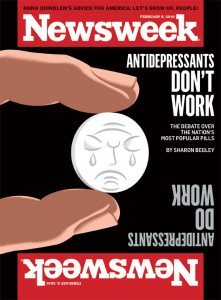Psychiatric Disorders Linked to More Physical Disease

In an article in the journal JAMA Network Open, Leah S. Richmond-Rakerd and colleagues found that people with mental disorders had more physical disease at younger ages, they had more and longer hospitalizations and associated health care costs, and they were more likely to die at younger ages than people without mental disorders.
The research came from a population-based cohort study of more than 2.3 million citizens of New Zealand over three decades. The authors concluded, “These findings suggest that ameliorating mental disorders may have implications for improving the length and quality of life and for reducing the health care costs associated with physical diseases.”
Editor’s Note: This editor would suggest the importance of also doing the opposite, that is, looking out for and treating and preventing the physical illnesses to which psychiatric patients are more vulnerable in order to improve the length and quality of life.
Either way, medical illnesses, both physical and psychiatric, are intimately intertwined, and both deserve careful and early intervention. Psychiatric and physical illnesses cause suffering, disability, and early demise. Major psychiatric illnesses need to be seen as potentially lethal medical illnesses, a fact that few people realize. Conversely, physical illnesses are often not treated as aggressively or intensively in psychiatric patients as in the general population. For example, patients with bipolar disorder get fewer interventions with stents and bypasses for the same heart problems as others. Special attention needs to be given to better encourage and support the medical health of psychiatric patients.
Smoking Ban in New Jersey Jails Drastically Reduced Deaths of Inmates with Mental Illness
Policy changes by the New Jersey Department of Corrections drastically reduced the availability of tobacco products in New Jersey jails between 2005 and 2014. Prison commissaries reduced their stock of tobacco, prices increased, sales to minors were banned, and facilities were designated tobacco-free (including for staff and visitors).
Along with this reduction in the availability of tobacco products, the Department of Corrections also introduced smoking cessation programs, began offering nicotine replacement lozenges in commissaries, and increased treatment for tobacco use.
A surprise consequence of the decision to go tobacco-free was a drastic reduction of deaths among prison inmates with mental illness. The mortality rate for these inmates dropped by 48%. In contrast, the mortality rate for inmates without mental illness remained flat before and after the tobacco ban.
People with mental illness are at increased risk of mortality, particularly from cardiovascular illnesses. Now it seems that eliminating tobacco use can go a long way toward improving health and reducing mortality for these people.
Malnutrition Early in Life Has Lasting Effects
Severe malnutrition in the first year of life even when corrected for the rest of a person’s life leaves a legacy of permanent cognitive deficits, marked deficits in attention, and increases in depression, conduct disorders, and medical disorders compared to carefully matched controls. Jamina Galler, a researcher at Harvard Medical School, gave a plenary talk at the 2013 meeting of the American Academy of Child and Adolescent Psychiatry on the long-term effects of even short-term childhood malnutrition, including marasmus (calorie deficiency) and kwashiorkor (protein deficiency).
Galler’s studies followed three generations of people born in Barbados and observed the consequences of prior malnutrition, which was completely eliminated in Barbados by 1980. The consequences of malnutrition in the first year of life not only affected the first (G1) generation, but subsequently their offspring in the G2 generation who also suffered an excess of attention-deficit hyperactivity disorder, low IQ, and low annual income into adulthood. That is, the early malnutrition had transgenerational effects.
Malnutrition is a huge problem worldwide and is especially bad in sub-Saharan Africa and some parts of Asia. Globally, malnutrition accounts for 50% of the deaths of children under age five. However, even in the US hunger is a problem for one in four children, or about 16 million individuals, and the long-term consequences of hunger remain to be further studied.
Studies in animals indicate that early malnutrition has epigenetic effects that can be passed on to four future generations before they are reversed. Epigenetic effects refer to environmental factors that cannot change the sequence of DNA, but change how easily it is transcribed by adding or taking away acetyl and methyl groups on DNA and histones, the structures around which DNA is wound. Malnutrition (defined as 6–8% casein, a type of protein, in the diet instead of the normal 25%) in rodents affects cognitive abilities and blood pressure and can lead to diabetes, obesity, and other metabolic abnormalities. The next generation is also affected because a previously malnourished mother huddles too much with her offspring, and they become obese as a result of these poor parenting skills. The second generation also exhibits epigenetic changes in the prefrontal cortex (such as too few glucocorticoid receptors due to methylation of the glucocorticoid promoter) and fewer neurons in the hippocampus.
Editor’s Note: Other data indicate similar long-lasting epigenetic and transgenerational effects of other types of childhood adversity, such as verbal, physical, or sexual abuse. These findings in humans are also paralleled by findings in animals, and give strong credence to the idea that the environment can have long-lasting effects on neurobiology and behavior via epigenetic effects that can be superimposed on whatever genetic effects are inherited.
Data from this editor (Robert Post) and colleagues on verbal abuse in childhood is striking; this supposedly less severe form of abuse is still associated with a more difficult course of bipolar disorder and an increase in medical comorbidities. Thus, the experience of early abuse, even just verbal abuse, appears to have long-lasting consequences for psychiatric and medical health into adulthood.
U.S. Patients with Bipolar Disorder Have More Stressors in Childhood and Prior to Illness Onset
In research published since 2008, our Editor-in-Chief Robert M. Post and colleagues in the Bipolar Collaborative Network have compared patients with bipolar disorder in the United States to those in Germany and the Netherlands. Compared to the European sample, patients in the US have more genetic vulnerability to bipolar disorder (by having a parent with bipolar disorder), earlier onsets of their illness, more complicated courses of illness, greater treatment resistance, and more medical comorbidities. Patients in the US also have more psychosocial stress.
The researchers are now turning their attention to these psychosocial vulnerabilities, and in a new paper that will be published in Psychiatry Research (late in 2013 or early in 2014), the authors show that patients in the US had more stressors both in childhood and just prior to the onset of their illness. Childhood stressors analyzed in the study were verbal abuse, physical abuse, and sexual abuse. Stressors in adulthood included indicators of a lack of social support, troubles with finances or employment, lack of access to health care, and medical comorbidities.
The stressors patients experienced just prior to their most recent episode of bipolar illness were related to: stressors in childhood, an earlier age of illness onset, anxiety and substance abuse comorbidity, lower income, both parents having an affective illness such as depression, and feeling more stigma.
The new research suggests that for patients with bipolar disorder in the US, adverse life events in childhood and later in life are more prevalent than they are for patients in the Netherlands or Germany. Earlier and more effective approaches to these stressors, such as the Family-Focused Therapy developed by David Miklowitz and Kiki Chang, could potentially slow the onset or progression of bipolar illness in this country.
Patients with Bipolar Depression Have a Higher Mortality Rate, Especially if They Also Have Cardiovascular Disease
In a large longitudinal study of depressed patients in Taiwan that was published in the Journal of Psychiatric Research this year, Chang et al. found that after 10 years, patients with bipolar depression (N=1,542) had significantly higher mortality rate than those with other types of depression (N=17,480). Patients with bipolar depression were twice as likely to have died from suicide or accidental death than were patients who had other types of depression. When cardiovascular disease was also present in both groups, patients with bipolar disorder were also four times more likely to have died from suicide or accidental death than those with other types of depression.
Editor’s Note: These data again emphasize the critical importance of patients with bipolar disorder carefully looking after their medical and cardiovascular health both early on and throughout the entire course of their illness.
Much of the excess medical mortality in bipolar disorder is attributed to cardiovascular disease, and now those with cardiovascular disease also appear more prone to suicide. This should be a call to action to improve the long-term treatment of both bipolar disorder and its common comorbidity, cardiovascular disease.
Get your medical illness treated!
It will improve your health and longevity. Especially treat these signs of the metabolic syndrome, a major risk factor for cardiovascular disease:
- Cholesterol–Increase “good” cholesterol (high-density lipoproteins or HDLs) and lower “bad” cholesterol (low-density lipoproteins or LDLs)
- High Triglycerides–Triglycerides should be below 150 mg/dL
- Blood Pressure–Aim for 130/85 mmHg or lower
- Blood Sugar–Fasting blood sugar (glucose) should stay below 100 mg/dL
- Overweight & Obesity–Keep waist circumference under 40” for men or 35” for women
Exercise is good for all of these!
The Risk-Benefit Ratio Encourages the Use of Antidepressants in Unipolar Depression
Wednesday we reviewed new data that shows that despite the FDA warning that antidepressants can increase suicidal ideation among young people in the first few months they are taken, antidepressants actually reduce acute suicidal ideation and decrease suicidal acts. As we described last year in our article on five myths about antidepressants, antidepressant treatment in recurrent unipolar depression is important to patients’ long-term wellbeing, cognitive functioning, and even life expectancy.
Untreated depression, and particularly untreated recurrent depression, carries high risks not only for lethality by suicide, but also for increases in medical mortality, particularly from cardiovascular disease. In addition to these medical risks, data from many studies suggest that a higher number of prior depressions is associated with increased cognitive dysfunction, and recent large data sets from a case registry in Denmark indicate that patients with four or more prior unipolar or bipolar depressive episodes have double the risk of receiving a diagnosis of dementia in old age. Thus, depressions are dangerous for a patient’s psychological, medical, and cognitive health.
Antidepressants Are Highly Effective in Depression Prevention
In 1992 researcher John Davis completed a meta-analysis of all antidepressant data available at the time in unipolar depression studies and not only found that antidepressant continuation was more effective than placebo in reducing the likelihood of later depressions, but also calculated that the statistical likelihood that this finding was due to chance was minuscule, i.e., p<10-34. John Geddes and colleagues in a meta-analysis in 2003 indicated that there was an approximate 70% reduction in the risk of depressive recurrences with antidepressant continuation compared with discontinuation.
Treatment of a first or second episode of unipolar depression is recommended for six to nine months following achievement of remission. After a third episode, all treatment guidelines of which this editor is aware recommend long-term preventive treatment with antidepressants, particularly if episodes have been severe or close together temporally. This long-term antidepressant continuation for prophylaxis is much like long-term treatment of high blood pressure or high cholesterol recommended for those with or at high risk for cardiovascular disease.
There is some evidence that cognitive behavior therapy reduces the risk for depressive recurrence in those discontinuing antidepressant treatment, but it appears maximally beneficial to engage both psychotherapeutic and pharmacological treatment to prevent future episodes. Read more
5 Myths About Unipolar Depression
 Early this year, news stories such as Newsweek’s “The Depressing News About Antidepressants” and “Antidepressant Drug Effects and Depression Severity” in the Journal of the American Medical Association (JAMA) created an inadequate picture of the seriousness of clinical depression, and the importance of preventing recurrent episodes with long-term antidepressant treatment. (For a rebuttal, see Psychiatric Times.)
Early this year, news stories such as Newsweek’s “The Depressing News About Antidepressants” and “Antidepressant Drug Effects and Depression Severity” in the Journal of the American Medical Association (JAMA) created an inadequate picture of the seriousness of clinical depression, and the importance of preventing recurrent episodes with long-term antidepressant treatment. (For a rebuttal, see Psychiatric Times.)
The consequences of this distorted depiction of depression and its treatment are potentially dire for individuals’ health. Some of the popular myths about depression deserve critical review so that patients can make more informed decisions about their own treatment.
Myth 1: Depression is all in your mind
Myth 2: Depression is over-treated
Myth 3: Antidepressant efficacy barely exceeds that of placebo
Myth 4: Antidepressants should be stopped as soon as possible
Myth 5: Depression is a minor medical problem
Myth 1: Depression is all in your mind
This might seem valid, since depression is classified as a mental illness. But depression is not abstract, imaginary, or lacking a solid physical foundation. There is now overwhelming evidence that depression coincides with disturbances in multiple brain and body systems.
More Medical Comorbidities Among Bipolar Population
Goldstein and colleagues interpreted data from the National Epidemiological Survey in 2001-2002 that included 41,682 representative adults in the U.S. population sampled compared with 1,411 found in the community with a diagnosis of bipolar disorder.
Those with bipolar disorder had a 3.86 times higher odds of having coronary heart disease compared with those in the general population. They were also 2.15 times more likely to have hypertension. Most disturbingly, the mean age of those with coronary heart disease in the general population was 62.1 years of age, but in those with bipolar illness, it was 50.4 years of age. This indicates that the markedly increased risk and incidence of coronary artery disease occurred approximately 11 years earlier in those with bipolar illness compared with those without. Most interestingly, the number of prior depressive episodes correlated with the presence of either coronary heart disease or hypertension.






